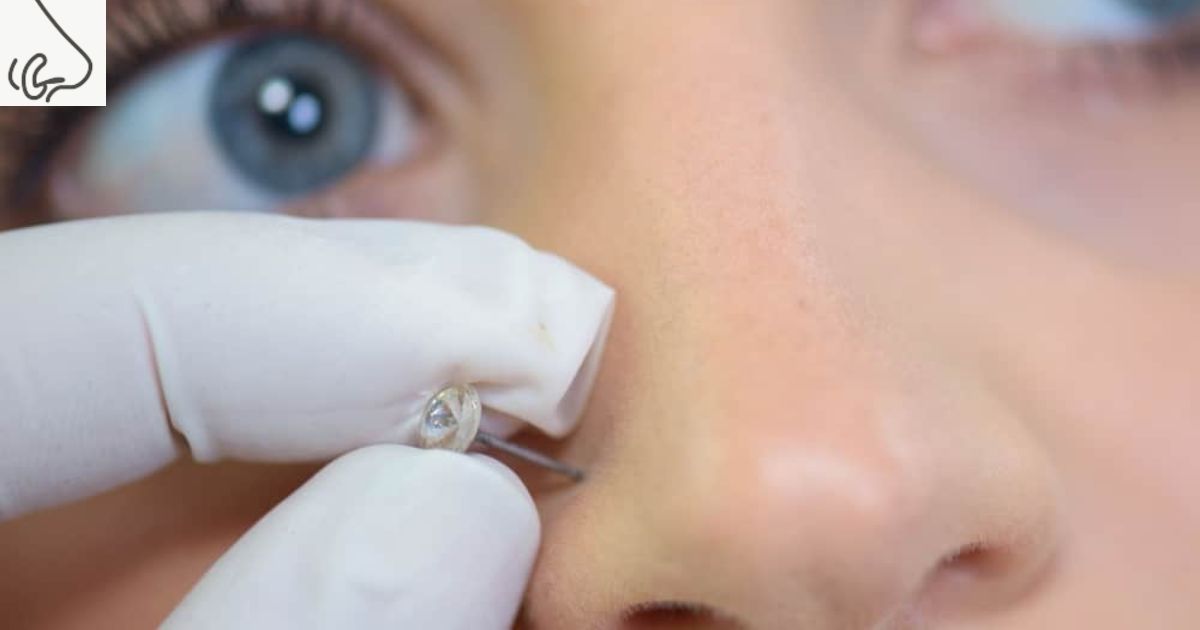Nose piercing has long been a popular form of self-expression and adornment, gracing the faces of countless individuals with a touch of style and individuality. The decision to get your nose pierced is often brimming with excitement and anticipation. It’s a statement of your unique identity. However, as you prepare to embark on this journey of self-expression and style, one question might give you pause: How do you numb your nose before piercing it at home? This guide explores various methods to ensure a comfortable and safe nose-piercing experience within the comfort of your own home.
Picture yourself in front of a mirror, holding the tools and the jewelry for your nose piercing, but with an additional item a numbing agent. The prospect of a less painful and more relaxed piercing process awaits. The use of numbing techniques is a game-changer in the world of at-home nose piercing. But how can you achieve it? We’ll delve into various methods that promise to make your nose piercing experience far more comfortable, even in the DIY setting of your home.
Before we explore the methods of numbing your nose at home, it’s essential to emphasize the significance of safety and hygiene throughout the process. Whether you opt for topical anesthetics, ice, or over-the-counter numbing creams, the key to a successful and safe experience lies in maintaining sterile conditions. From cleaning your hands and the piercing area to the selection of high-quality piercing jewelry, safety and hygiene should be your guiding principles. Proceeding with caution and care is the essence of this guide, and by following the right methods and safety precautions, you can achieve the nose piercing you desire while minimizing pain and discomfort.
Understanding the Importance of Numbing
Before we dive into the methods of numbing your nose, it’s crucial to understand why it’s essential
Pain Reduction: Nose piercings can be painful, and numbing helps reduce the discomfort during the piercing process.
Relaxation: Numbing your nose helps you stay calm and relaxed, which is important for a successful piercing.
Precise Piercing: A numb nose allows for a more precise and accurate piercing, minimizing the risk of complications.
Method1: Topical Anesthetics
| Method | Steps |
| Topical Anesthetics | 1. Choose the Right Product: Opt for a topical anesthetic cream or gel. |
| 2. Clean the Area: Wash your nose thoroughly with mild soap and water. | |
| 3. Apply the Anesthetic: Using a cotton swab, apply a generous amount to the piercing area. | |
| 4. Wait for Numbing: It takes about 20-30 minutes for full numbing. | |
| 5. Pierce Your Nose: Proceed with piercing after the area is numb. | |
| Ice Cubes | 1. Get Ice Cubes: Wrap a few ice cubes in a clean cloth or paper towel. |
| 2. Apply to the Nose: Gently press the ice-covered cloth against the piercing area for 15-20 minutes. | |
| 3. Check Numbness: Verify numbness by gently touching the area. | |
| 4. Pierce Your Nose: Proceed once the area is numb and maintain a sterile environment. | |
| Over-the-Counter Numbing Creams | 1. Select the Right Cream: Purchase a recommended over-the-counter numbing cream. |
| 2. Clean Your Nose: Clean the area with soap and water and dry gently. | |
| 3. Apply the Cream: Carefully apply a thick layer of numbing cream. | |
| 4. Wait for Numbing: It takes around 20-30 minutes for full numbing. | |
| 5. Proceed with Piercing: Once the area is numb, follow proper hygiene and piercing procedures. | |
| Important Tips for Safe Numbing and Piercing | 1. Follow Sterile Procedures: Maintain cleanliness throughout the process. |
| 2. Seek Assistance: If uncomfortable, ask a friend or family member for help. | |
| 3. Practice Patience: Ensure complete numbness before piercing to minimize pain. | |
| 4. Use Quality Jewelry: Invest in high-quality nose piercing jewelry for safety. |
Topical anesthetics are readily available and easy to use. Here’s how to apply them:
- Choose the Right Product: Opt for a topical anesthetic cream or gel that contains ingredients like lidocaine or benzocaine. These ingredients are effective at numbing the skin.
- Clean the Area: Wash your nose thoroughly with mild soap and water to remove any dirt or oil. Pat it dry with a clean cloth.
- Apply the Anesthetic: Using a cotton swab, apply a generous amount of the anesthetic to the area where you plan to pierce your nose. Ensure you cover the entire area.
- Wait for Numbing: Most anesthetics take around 20-30 minutes to fully numb the skin. During this time, the sensation in your nose will gradually diminish.
- Wash Your Face with a Nose Piercing: Once the area is sufficiently numb, you can proceed with piercing your nose. Be cautious and follow proper hygiene procedures.
Method 2: Ice Cubes
Ice Cubes
Using ice is a natural and effective method to numb your nose. Here’s how to do it:
- Get Ice Cubes: Take a few ice cubes and wrap them in a clean cloth or paper towel.
- Apply to the Nose: Gently press the ice-covered cloth against the area you intend to pierce. Hold it in place for about 15-20 minutes.
- Check Numbness: After 15-20 minutes, check if the area is numb by gently touching it. If you still feel sensation, you can apply the ice for a few more minutes.
- Pierce Your Nose: Once the area is numb, you can proceed with the piercing. Ensure you maintain a sterile environment and follow proper piercing techniques.
Method 3: Over-the-Counter Numbing Creams
Over-the-Counter Numbing Creams

There are over-the-counter numbing creams available that are specifically designed for pain relief during piercings. Here’s how to use them:
- Select the Right Cream: Purchase an over-the-counter numbing cream that is recommended for topical use on the skin.
- Clean Your Nose: Clean your nose and the surrounding area with soap and water. Dry it gently with a clean cloth.
- Apply the Cream: Carefully apply a thick layer of the numbing cream to the area where you plan to pierce your nose.
- Wait for Numbing: These creams typically take around 20-30 minutes to fully numb the skin.
- Proceed with Piercing: Once the area is sufficiently numb, you can proceed with the nose piercing. Ensure that you maintain sterile conditions and use the appropriate piercing equipment.
Important Tips for Safe Numbing and Piercing
Important Tips for Safe Numbing and Piercing
- Follow Sterile Procedures: Maintain cleanliness during the entire process. Cleanse your hands, the piercing area, and all tools and equipment.
- Seek Assistance: If you’re uncomfortable numbing and piercing your nose by yourself, consider asking a friend or family member for assistance.
- Practice Patience: Ensure that the numbness is complete before piercing. Waiting for the proper level of numbness is crucial to minimize pain.
- Use Quality Jewelry: Invest in high-quality nose piercing jewelry to minimize the risk of complications and allergic reactions.
FAQs
- How soon can I wash my face after getting a nose piercing?
- You can begin washing your face carefully after 24 hours, following your piercer’s instructions.
- Can I use any facial cleanser for washing my face with a new nose piercing?
- It’s best to choose a gentle, fragrance-free, and hypoallergenic cleanser that won’t irritate your piercing.
- Do I need to remove my nose piercing jewelry when washing my face?
- It’s not necessary to remove it for regular face washing, but you should follow specific steps for cleaning around the jewelry.
What should I do if I notice redness or irritation around my nose piercing after washing my face?
-
- Rinse your piercing area with saline solution, avoid overcleaning, and consult your piercer if the issue persists.
- How often should I change my pillowcases to prevent issues with my nose piercing?
-
- Changing your pillowcases every 2-3 days or using a clean towel over your pillow each night can help maintain piercing hygiene.
Conclusion
Numbing your nose before piercing at home can be an effective way to minimize pain and ensure a successful piercing experience. However, it’s essential to prioritize safety and hygiene throughout the process. If you have any doubts or concerns, consider seeking professional assistance. Remember that improper piercing techniques or poor hygiene can lead to complications, so always proceed with caution and care. By following the right methods and safety precautions, you can achieve your desired nose piercing while minimizing discomfort and risks.



















